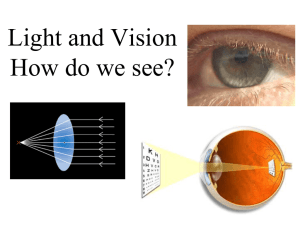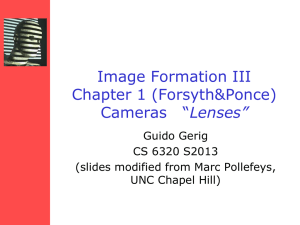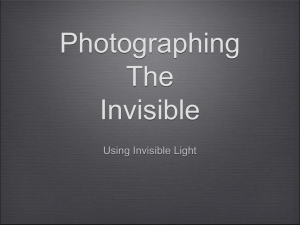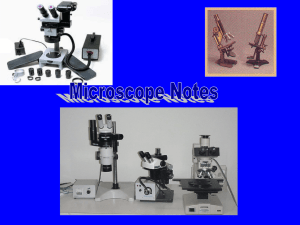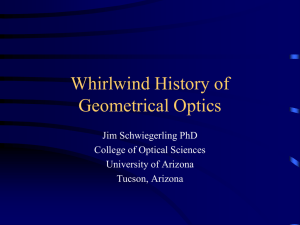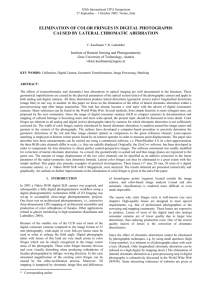ABCD Matrix (Cont
advertisement
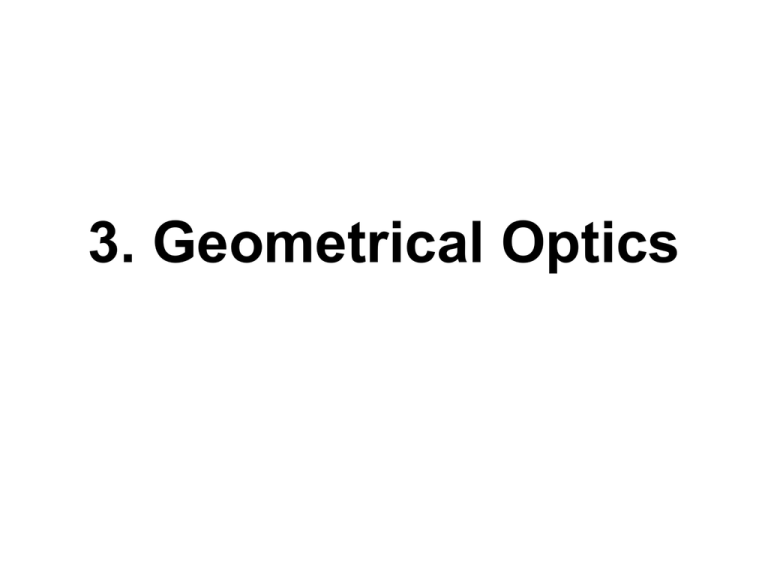
3. Geometrical Optics Geometric optics—process of light ray through lenses and mirrors to determine the location and size of the image from a given object . Reflection and Mirror Law of reflection i r i : incidentangle r : reflectionangle Image Formation by Reflection Application of Double Reflection-Periscope DIY Periscope DIY Periscope (Cont’) Law of reflection (Snell’s law) n1 sin 1 n2 sin 2 Types of Lenses Ray Tracing through Thin Lenses Image Formation by thin Lenses Lens equation: 1 1 1 (Gaussian form) d1 d 2 f f 2 z1 z2 (Newtonianform) Magnification h2 d 2 M h1 d1 ABCD Matrix ABCD Matrix (Cont’) ABCD Matrix (Cont’) ABCD Matrix (Cont’) ABCD Matrix (Cont’) ABCD Matrix (Cont’) ABCD Matrix (Cont’) Aberrations of Lenses • Primary Aberration image deviate from the original picture/the first-order approximation Monochromatic aberrations Spherical Aberration Coma Astigmatism Curvature of field Distortion Chromatic aberration General Method of Reducing Aberration in Optical Systems-Multiple Lenses United States Patent 6844972 General Method of Reducing Aberration in Optical Systems-Multiple Lenses (Cont’) United States Patent 6995908 Chromatic Aberration The focal lengths of lights with distinct wavelengths are different. Solution of Chromatic Aberration-Using Doublet, Triplet, or Diffractive Lens Spherical Aberration (SA) Spherical Aberration for Different Lenses (a) (b) (c) (d) Simple biconvex lens “Best-form” lens Two lenses Aspheric, almost plano-convex lens Solutions of Spherical AberrationUsing Aspherical Lens or Stop Coma Coma (Cont’) (a) Negative coma (b) Postive coma Astigmatism Astigmatism (Cont’) Solutions of Astigmatism-Using Multiple Lenses Curvature of field Solutions of Curvature of field-Using Multiple Lenses Distortion Picture taken by a wide-angle camera in front of graph paper with square grids Solution of Distortion-Using Multiple Lenses Nearsightedness (Myopia) and Farsightedness (Hyperopia) Image Formation Camera Camera F-number F num ber focal length diameterof aperture Eg. 50 mm camera lens, aperture stop 6.25mm: F-number = 8 (f/8) Exposure BA Bd 2 E 2 f 4f 2 E: energy collected by camera lens B: brightness of object A: area of aperture d: diameter of aperture stop For any given object E 1 (F - number)2 Camera Lenses • Wide-angle Lensesthe Aviogon and the Zeiss Orthometer lenses • Standard Lenses-the Tessar and the Biotar lenses • Lens of reducing the 3rd-order aberrationthe Cooke triplet lens Depth of Field (DOF) • The distance between the nearest and farthest objects in a scene that appear acceptably sharp in an image. • In cinematography, a large DOF is called deep focus, and a small DOF is often called shallow focus. • For a given F-number, increasing the magnification decreases the DOF; decreasing magnification increases DOF. • For a given subject magnification, increasing the F-number increases the DOF; decreasing F-number decreases DOF. Numerical Aperture (NA) • The numerical aperture of an optical system is a dimensionless number that characterizes the range of angles over which the system can accept or emit light. • Generally, • For a multi-mode optical fiber, Telescope Astronomical (Keplerian) Telescope Magnification (magnifying power): General Keplerian telescope: d=fo+fe ' : angle subtended at input end in front of objective ’: angle subtended at output end behind eyepiece M For small angle: f ' M o 0 fe (inverted image) Galileo Telescope ' fo M 0 fe General Galileo telescope: d=fo-fe Terrestrial Telescope All images are erecting Optical Microscope Microscope Theory Overall magnification: M mo me mo: linear magnification of objective me: angular magnification of eyepiece Objective Linear magnification: m o y' x' y f Numerical aperture (NA) NA D 1 (for objective) f F - number Microscope Theory (Cont’) Eyepiece y (if 1) 25 Angular magnification: tan me ' 25 25 1 (usually, f 25cm ) f f ' tan ' y' y (if ' 1) 25 x Overall magnification of microscope: M mo me x ' 25 f o fe fo: focal length of objective fe: focal length of eyepiece (normal reading distance) Simple Projection System Fresnel Lens and Plates focusing point (in phase) • Radius of the concentric circular: rn = [(n)2+2fn] ½ , n=0, 1, 2,…. • Sapce between two adjacent circular • zone: rn = rn+1rn

